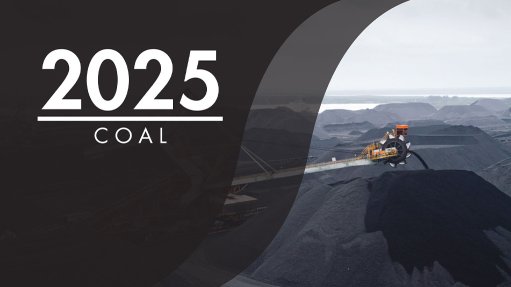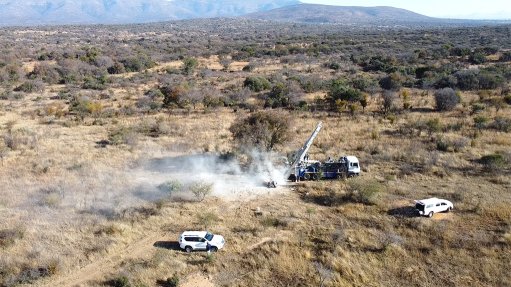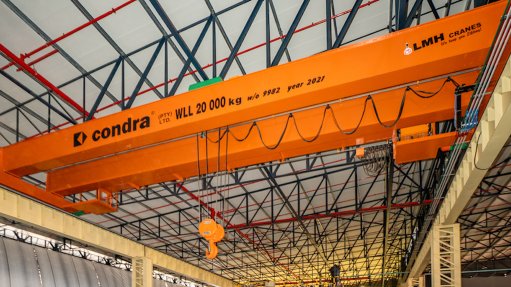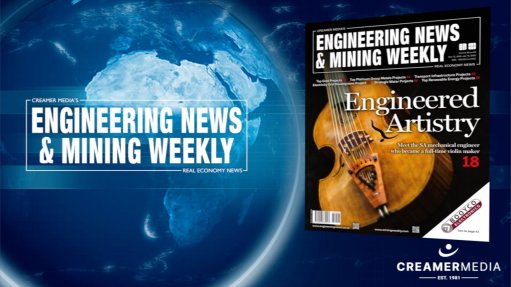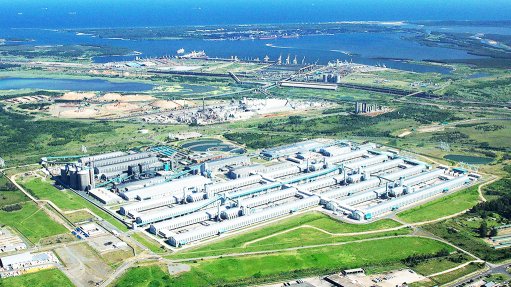Experts agree new mining technology must be impactful, measurable for wider adoption

A panel of experts dive into the cutting-edge strategies and technologies that are improving mine performance and redefining what’s possible in this Creamer Media-hosted webinar.
Understanding the drivers of the adoption of new technology in the mining industry has never been more pertinent, as the world adapts to climate change and manages an uncertain economic outlook and radical trade regimes that influence mineral supply chains and prices.
A panel of speakers participating in a webinar hosted by Creamer Media on August 27 concurred that the drivers of technology adoption in mining were multifold – cost reduction, environmental-impact management, safer operations, better waste management and efficiency for competitiveness.
During the webinar, which was sponsored by commercial blasting solutions company BME, specialist gold recovery company DRDGOLD, fuel and lubricants group Engen Petroleum, fuel retailer Vivo Energy, mining ventilation company TLT-Turbo Africa, energy connection products company Aberdare and mineral research and technology organisation Mintek, the speakers agreed that pressure is mounting on companies to operate more sustainably and that innovations that support responsible and low-impact mining need to be scaled.
The panel of experts comprised Hyve Group content and strategic partnerships head Laura Nicholson as the facilitator and co-host on behalf of the Investing in African Mining Indaba; Mintek hydrometallurgy executive director Dr Elmark Muller; BME technology and marketing GM Nishen Hariparsad; DRDGOLD CEO Niël Pretorius; Engen Petroleum national sales manager Simon Prevett; and Mandela Mining Precinct (MMP) director Julie Courtnage.
Courtnage stressed the importance of doing more with less as resource scarcity became a central focus for global stakeholders, while Muller pointed out how South Africa’s historic mining legacy meant older infrastructure needed to be overhauled and retrofitted to remain aligned with environmental, social and governance principles.
Hariparsad said mining companies often struggled to choose between the vast technology options available, hence the importance of determining sustainable growth solutions that solve real problems for the organisation. He emphasised the key to new technology adoption was buy-in from stakeholders, including employees that would be using the technology.
Pretorius agreed, stating the necessity of being mindful of many things when trying to adopt a new system into established protocols. “People do not want you to experiment on something that has been working well. You have to implement new technology incrementally and with buy-in. Technical experts and operators need to be convinced of the value of new systems.”
He further mentioned that risk management, data and predictive analysis had become indispensable in ensuring accurate and meaningful efforts to improve operational excellence and make mining safer.
For example, DRDGOLD measures, in real time, each layer of tailings at its newest tailings facility near Fochville, in the North West, which provides assurance on the likelihood of disasters occurring.
Pretorius explained there was a device on site that drove over newly compacted material and automatically measured the density, compaction and moisture content of the newest layer, thereby discovering faults immediately rather than ten years later when multiple layers of tailings had been set.
Prevett agreed with the other experts that greater efficiencies often contributed to cost reduction, particularly in the petroleum industry, which was significantly focused on environmental impact and emission reduction.
In this regard, Engen Petroleum has various products and services that drive efficiency for customers, including dynamic diesel that uses a bespoke additive technology called ProDrive, which improves atomisation in combustion chambers and keeps injectors cleaner for longer.
“In essence, we are seeing better responses from equipment, power use improvements and fuel efficiency. From an environmental perspective, these improvements are significant.
“On the lubricants side, we have a comprehensive range of future-ready lubricants that ensure extended component life and higher equipment availability,” Prevett stated.
To ensure greater impact in the whole mining industry – improved cost savings and environmental-impact reduction – Muller said more research and development was necessary.
However, Mintek, as a frontier research organisation focusing on various technology developments, recognised how capital allocation over long-term investment cycles might leave less room for this kind of spend.
Mintek has developed many specific mineral processing technologies, as well as water stewardship support and energy-transition-type technologies, which ultimately make mining “cleaner”. The organisation offers chemical processes to reduce sulphates in mine-impacted water, and hydrogen reduction methods for reduced carbon from furnaces.
The organisation’s bio-metallurgy division is currently investing in heap-leach methods that are more efficient and accessible for small-scale miners.
Muller said Mintek was not only constantly developing new technology, but also focused on improving older technology that had been on the market for a long time, which was vital to contain costs for small-scale miners.
The MMP, as another research organisation supporting industry development efforts, has advanced various productivity-enhancing technology such as autonomous and remotely operated mining equipment for South Africa’s deep orebodies, real-time management systems, interoperability systems combining individual types of software, 3D modelling of rocks to guide more precise drilling and a tool to help organisations determine what the best digital tools for their operation would be.
A notable development is one of MMP’s collaborative research programmes, the Isidingo drill, which is 50% lighter than standard drills, making it easier for women to use, while using less water and energy.
Pretorius noted how important 24/7 measuring and monitoring had become in making plants more predictable and stable, which also helped to reduce cyanide consumption and maintain densities and temperatures for longer equipment life and consistent production output.
“Our operational conversations are becoming far more analytical. From an environmental and visibility perspective, technologies for monitoring pipelines for leaks, for example, have become extremely valuable,” he added.
On this topic, Hariparsad said the effective use of analytics and digital technologies across the mining value chain not only improved efficiency but steered mining companies to better meet the needs of their markets.
“We have partner systems that have been purposefully designed to unlock measurable value, including better fragmentation, reduced downtime and downstream benefits such as faster processing capability from more precise blasting,” he explained.
Hariparsad motivated that companies such as BME sold predictability and empowerment, allowing customers to do more with what they had.
Commenting on barriers to technology adoption, Courtnage said no company could divorce technological development from the realities of mining investment cycles and organisational contexts. The MMP had grown to offer technology-readiness and human-readiness evaluations before companies installed new systems.
She added that there was often a lack of awareness of what was available, hence the importance of partnerships and knowledge-sharing among service providers and mining companies for the greater good of the industry.
Hariparsad agreed that technology should not be implemented in isolation and should rather be implemented through partnerships to ensure meaningful, measurable and valuable impact.
In concluding, Nicholson said even the best technology in the world was meaningless without buy-in from the people who would be using it and benefitting from it, and that it must solve current problems in the industry, including improving the quality of life of stakeholders and communities.
Article Enquiry
Email Article
Save Article
Feedback
To advertise email advertising@creamermedia.co.za or click here
Press Office
Announcements
What's On
Subscribe to improve your user experience...
Option 1 (equivalent of R125 a month):
Receive a weekly copy of Creamer Media's Engineering News & Mining Weekly magazine
(print copy for those in South Africa and e-magazine for those outside of South Africa)
Receive daily email newsletters
Access to full search results
Access archive of magazine back copies
Access to Projects in Progress
Access to ONE Research Report of your choice in PDF format
Option 2 (equivalent of R375 a month):
All benefits from Option 1
PLUS
Access to Creamer Media's Research Channel Africa for ALL Research Reports, in PDF format, on various industrial and mining sectors
including Electricity; Water; Energy Transition; Hydrogen; Roads, Rail and Ports; Coal; Gold; Platinum; Battery Metals; etc.
Already a subscriber?
Forgotten your password?
Receive weekly copy of Creamer Media's Engineering News & Mining Weekly magazine (print copy for those in South Africa and e-magazine for those outside of South Africa)
➕
Recieve daily email newsletters
➕
Access to full search results
➕
Access archive of magazine back copies
➕
Access to Projects in Progress
➕
Access to ONE Research Report of your choice in PDF format
RESEARCH CHANNEL AFRICA
R4500 (equivalent of R375 a month)
SUBSCRIBEAll benefits from Option 1
➕
Access to Creamer Media's Research Channel Africa for ALL Research Reports on various industrial and mining sectors, in PDF format, including on:
Electricity
➕
Water
➕
Energy Transition
➕
Hydrogen
➕
Roads, Rail and Ports
➕
Coal
➕
Gold
➕
Platinum
➕
Battery Metals
➕
etc.
Receive all benefits from Option 1 or Option 2 delivered to numerous people at your company
➕
Multiple User names and Passwords for simultaneous log-ins
➕
Intranet integration access to all in your organisation






